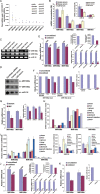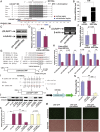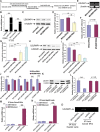Exogenous plant MIR168a specifically targets mammalian LDLRAP1: evidence of cross-kingdom regulation by microRNA
- PMID: 21931358
- PMCID: PMC3351925
- DOI: 10.1038/cr.2011.158
Exogenous plant MIR168a specifically targets mammalian LDLRAP1: evidence of cross-kingdom regulation by microRNA
Erratum in
- Cell Res. 2012 Jan;22(1):273-4
Abstract
Our previous studies have demonstrated that stable microRNAs (miRNAs) in mammalian serum and plasma are actively secreted from tissues and cells and can serve as a novel class of biomarkers for diseases, and act as signaling molecules in intercellular communication. Here, we report the surprising finding that exogenous plant miRNAs are present in the sera and tissues of various animals and that these exogenous plant miRNAs are primarily acquired orally, through food intake. MIR168a is abundant in rice and is one of the most highly enriched exogenous plant miRNAs in the sera of Chinese subjects. Functional studies in vitro and in vivo demonstrated that MIR168a could bind to the human/mouse low-density lipoprotein receptor adapter protein 1 (LDLRAP1) mRNA, inhibit LDLRAP1 expression in liver, and consequently decrease LDL removal from mouse plasma. These findings demonstrate that exogenous plant miRNAs in food can regulate the expression of target genes in mammals.
Figures






Comment in
-
Lack of detectable oral bioavailability of plant microRNAs after feeding in mice.Nat Biotechnol. 2013 Nov;31(11):965-7. doi: 10.1038/nbt.2737. Nat Biotechnol. 2013. PMID: 24213763 No abstract available.
-
Reply to Lack of detectable oral bioavailability of plant microRNAs after feeding in mice.Nat Biotechnol. 2013 Nov;31(11):967-9. doi: 10.1038/nbt.2741. Nat Biotechnol. 2013. PMID: 24213764 No abstract available.
-
Mining of public sequencing databases supports a non-dietary origin for putative foreign miRNAs: underestimated effects of contamination in NGS.RNA. 2014 Jun;20(6):754-7. doi: 10.1261/rna.044263.114. Epub 2014 Apr 11. RNA. 2014. PMID: 24729469 Free PMC article.
References
-
- Bartel DP. MicroRNAs: genomics, biogenesis, mechanism, and function. Cell. 2004;116:281–297. - PubMed
-
- He L, Hannon GJ. MicroRNAs: small RNAs with a big role in gene regulation. Nat Rev Genet. 2004;5:522–531. - PubMed
-
- Calin GA, Croce CM. MicroRNA signatures in human cancers. Nat Rev Cancer. 2006;6:857–866. - PubMed
-
- Esquela-Kerscher A, Slack FJ. Oncomirs – microRNAs with a role in cancer. Nat Rev Cancer. 2006;6:259–269. - PubMed
-
- Chen X, Ba Y, Ma L, et al. Characterization of microRNAs in serum: a novel class of biomarkers for diagnosis of cancer and other diseases. Cell Res. 2008;18:997–1006. - PubMed
Publication types
MeSH terms
Substances
LinkOut - more resources
Full Text Sources
Other Literature Sources
Medical
Research Materials

